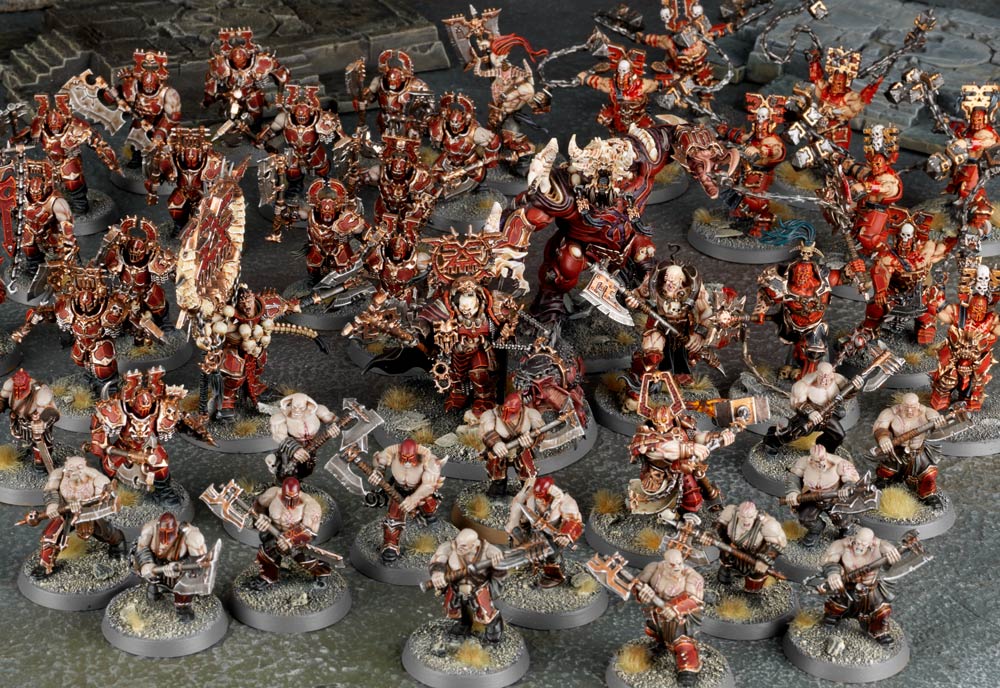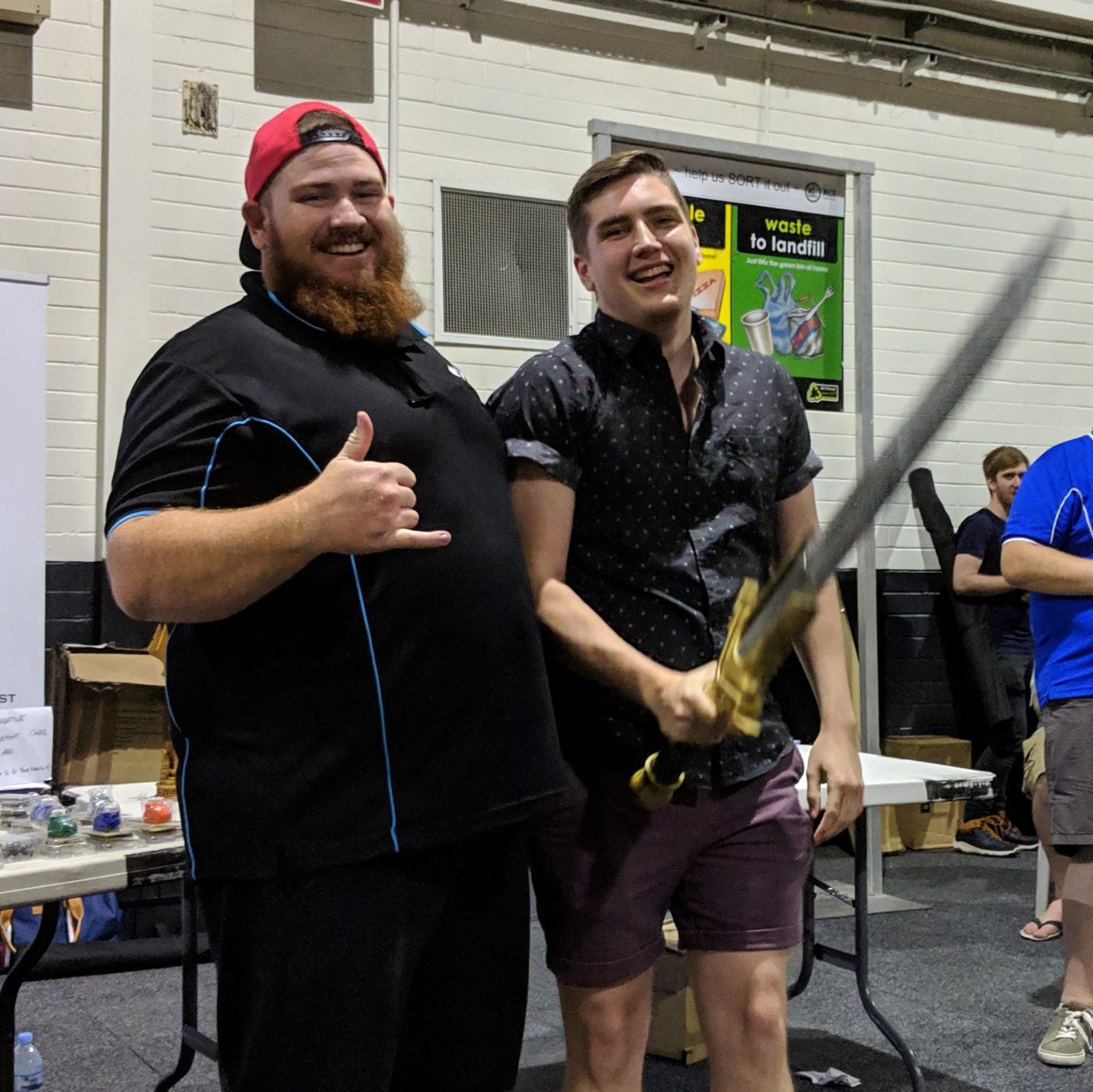Hey all, today I have an article written by Matt Campbell, 1st out of ~200 players at CanCon 2019, on his Blades of Khorne list and Age of Sigmar list writing for matched play. Matt covers his list and the factors which went into its creation and play on the tabletop – the battleplans, the likely opponents he would face and more.
If you want to read more coverage of CanCon 2019 you can check out:
- the Order lists, Death lists, Chaos lists, and Destruction lists;
- the awards and top results;
- the full results post;
- the Tasman Cup report;
- my report on the event.
And, as always, check out Dark Fantastic Mills for great 3D printed terrain perfect for wargaming. Its super versatile and light so worldwide shipping is inexpensive. Use the “aos shorts” discount code for a further 10% off the already decent prices.

Introduction
Two weeks ago, the Heralds of War (Clint Mallet and the rest of his super team) held what is to date the largest Warhammer Age of Sigmar singles event the world has ever seen. After six great games spread over two days my Blades of Khorne were able to pull off first place with six major wins.
In this write up, I fully intended to provide an in-depth account of the way I go about playing Khorne in Age of Sigmar Second Edition. However recent revelations from the Las Vegas Open Studio Preview confirmed the next Age of Sigmar battletome will be Khorne! While this is of course awesome news for all the Khorne players out there it does mean that a write up of my specific list will have a relatively short shelf life.

With this in mind, I instead intend to shed some light on CanCon for those unfamiliar with the event and then elaborate on what I feel is the best way to plan for a large tournament if you have an aim of being competitive. Hopefully this advice will remain useful for tournament goers who either lack experience or even more experienced players who want to push on to achieve a higher success rate at tournaments.
Background to CanCon 2019
CanCon, as the name suggests, is a convention held in Canberra, specifically it is Australia’s preeminent wargaming convention and takes place over the Australia Day long weekend (late January). Since the inception of Age of Sigmar, Clint’s events, officially named ‘Call to Glory’ have essentially doubled in size each year (#makeit400). This year we saw 200 players attend (give or take) and was a wonderful, inviting, community driven event which served to showcase the Aussie Age of Sigmar scene in all its glory. If you didn’t go this year and love the hobby, if at all possible I urge you to come next year, 200 people went and i’m yet to hear about somebody who didn’t love it.

My plan for CanCon 2019
Although I consider myself a competitive player, my aim going into the weekend was not to win the event, but rather the aim was to enjoy six great games and hopefully compete for best Khorne. I reasoned that with so many great players and so many great armies attending, setting the goal of winning the whole thing would be too ambitious an aim. That being said my hobby is based around competitive play and as a result I planned my list accordingly.
Matt’s winning list
Allegiance: Khorne
Mortal Realm: Ghyran
Wrath of Khorne Bloodthirster (320) – General – Trait: Immense Power – Artefact: The Crimson Crown
Bloodthirster of Insensate Rage (260) – Artefact: Ghyrstrike
Bloodstoker (80)
Bloodsecrator (140)
Slaughterpriest (100)
Slaughterpriest with Hackblade and Wrathhammer (100)
5 x Blood Warriors (100) – Goreaxes
10 x Bloodreavers (70) – Reaver Blades
10 x Bloodreavers (70) – Reaver Blades
10 x Flesh Hounds (200)
10 x Skullreapers (340) – Daemonblades – 2x Soultearers
Battalions Gore Pilgrims (200)
Points Total: 1980 / 2000 Extra Command Points: 1 Allies: 0 / 400

CanCon 2019 planning
When designing my list I kept in mind both the battleplans we would be playing and the lists I would likely be playing against. In order to be competitive I knew that I would need the tools to cope with the sort of lists that form our current meta (Grimghast Reaper heavy Legions of Nagash, Deepkin lists with lots of eel cavalry, Daughters of Khaine, Sacrosanct Chamber, etc) as well as the tools to complete the objectives within the battleplans.

Tools to deal with different opponents
When dealing with the aforementioned lists, I ensured that I was able to remove chaff/target characters when dealing with Legions of Nagash and Daughters of Khaine (Range from Wrath of Khorne Bloodthirster, explosion from the Insensate Rage Bloodthirster and prayers from the priests to either move screens or inflict mortal wounds at range).
I also made sure I had the chaff to zone out the eels with my Blood Reavers, Warriors and at a push Flesh Hounds.
Lastly to combat the Sacrosanct Chamber I wanted to have the speed to ensure that I could pin their combat units in place as well as lessen the ranged threat of ballistas.
It’s an awful feeling when you are matched against an opponent whose army includes a mechanic that you can’t counter, planning like this can limit the chance of one of these moments occurring in a tournament and in theory should always leave you with a fighting chance.

Planning for battleplans
Planning around the battleplans is generally a more straightforward process, most of the match ups required models around objectives scoring. To achieve these scenarios I ensured that I included a sufficient amount of bodies which would either be mobile enough to get on objectives quickly or robust enough to hold them once they arrived.
The real challenge personally was Places of Arcane Power, a mission in which wizards or heros with artefacts count as 20 models. Considering no self respecting Khorne general would bring a wizard to an event I knew that having 2 Bloodthirsters holding artefacts would provide much needed numbers on the objectives as they are both fast and relatively robust.
It is important to note that all armies have different strengths and weaknesses, for example a Beastclaw Raiders army is unlikely to be high model count, while a Gloomspite Gitz army although often have a large amount of wizard, most of them are not particularly survivable. When designing a list it’s crucial to ensure that not only can you identify the weaknesses within but also take steps to strengthen them.
Tactics throughout the tournament
While planning for the meta can be crucial in terms of list building its important to alter your play style against each opponent and the different battleplan you are playing. I find the easiest way of doing this is to identify an achievable goal that will swing the game in your favour.
Focus on the heroes
For example, in my first game at CanCon 2019, I played Elisabeth Lockhart’s Legion of Blood army featuring 3 large heroes and a 40 block of skellies, in this case the heroes were Neferata (general), Vampire Lord on Zombie Dragon, Coven throne and a Banshee. When playing Legions of Nagash my first question will always be if i can kill the general, this is crucial as the general can bring back summonable units for free (such as the 40 skellies). Luckily for me, Neferata was left exposed and she like the other mortarchs is relatively squishy, this meant I was able to take her out with a Bloodthirster making the match far more manageable. Overall my approach to this game was largely aggressive because once Neferata died I knew that killing the Coven Throne and the skellies meant it would be extremely hard to for Elisabeth to come back into the game.

Know when to bide your time
Contrast this against my game with Matt Tyrell in round 4 who also ran Legion of Blood. However, a different opponent, different list and different battleplan (Relocating Orb) would mean I had to adopt a different play style. Matt had a Vampire Lord on Zombie Dragon as his general and rather than featuring multiple behemoths he instead invested in powerful combat units such a large blobs of spirit hosts, black knights and skellies. With a more resilient general and such powerful summonable units to bring back I played more conservatively, ensuring that I went up on the scenario each turn and put models over the gravesite near his Zombie Dragon so that he couldn’t bring back units. Eventually I did manage to kill the dragon (who rolled terribly) and grind out his army but the game was far more attritional than my first. Which is is never a bad thing as long as you identify it early and don’t throw away your key pieces early on.

Variety of challenges
Throughout the weekend I also played Beasts of Chaos (hard hitting Gavespawn list), Gloomspite Gitz (horde heavy), Daughters of Khaine (teleporting multiple threats around the board) and finally Kharadron Overlords (all the shooting in the world). Ultimately all of the armies I played were extremely different and using the same strategy against all of them would have resulted in getting found out against some very good players. Only by tailoring my tactics and strategy to each opponent was I able to pull out the win.

Closing thoughts
Ultimately for a lot of you, what I’ve said won’t be news, most experienced tournament goers will know that planning is crucial but reacting to your opponent is even more important. If however you’re relatively new to the tournament scene then hopefully some of this is useful and helps you get the results you want in future events. Just remember to plan for your own armies’ strong suits, plan for the meta, plan for the battleplan but be ready to adapt to your opponent and you shouldn’t go too far wrong.


Leave a Reply
You must be logged in to post a comment.